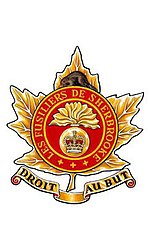|
Fusiliers de Sherbrooke
Les Fusiliers de Sherbrooke is a Primary Reserve infantry regiment of the Canadian Army. It is based in Sherbrooke, Quebec, with a sub-unit in Granby. BadgeA grenade with the Crown superimposed upon the ball within an annulet inscribed Les Fusiliers de Sherbrooke, surmounted by a beaver and super-imposed upon a maple leaf; the whole resting on a scroll inscribed Droit au but.[1] Lineage
Les Fusiliers de Sherbrooke
Early in World War II the Sherbrooke Fusiliers Regiment was formed with men from Les Fusiliers de Sherbrooke and The Sherbrooke Regiment. Shortly after establishment, the spelling was changed to "Fusilier", as in Sherbrooke Fusilier Regiment. Lineage chart
PerpetuationsThe Great WarOperational historyThe Great WarDetails of the 54th Regiment "Carabiniers de Sherbrooke" were called out on active service on 6 August 1914 for local protection duties.[5] The 163rd Battalion (French-Canadian), CEF was authorized on 22 December 1915 and embarked for Bermuda on 26 May 1916 for garrison duty. It sailed from Canada for Great Britain on 27 November 1916 where it was absorbed by the 10th Reserve Battalion, CEF, on 8 January 1917 to provide reinforcements for the Canadian Corps in the field. The battalion disbanded on 15 September 1917.[6] The Second World War Les Fusiliers de Sherbrooke, in conjunction with The Sherbrooke Regiment (Machine Gun) (now The Sherbrooke Hussars), mobilized The Sherbrooke Fusiliers Regiment, CASF for active service on 24 May 1940. The name Fusilier was plural initially but subsequently changed to singular. It was redesignated as the 1st Battalion, The Sherbrooke Fusiliers Regiment, CASF on 7 November 1940 and as the 1st Battalion, The Sherbrooke Fusilier Regiment, CASF on 15 November 1940. The 1st Battalion was converted to an armoured regiment on 26 January 1942 and designated as the 27th Armoured Regiment (The Sherbrooke Fusilier Regiment), CAC, CASF. By this time the name Fusilier was singular. It was redesignated as the 27th Armoured Regiment (The Sherbrooke Fusilier Regiment), RCAC, CASF on 2 August 1945. The regiment served in Newfoundland on garrison duty from 13 August 1941 to 15 February 1942, and embarked for Great Britain on 27 October 1942. On D-Day, 6 June 1944, it landed in Normandy, France as part the 2nd Canadian Armoured Brigade, and it continued to fight in North West Europe until the end of the war. The overseas regiment was disbanded on 15 February 1946.[7] The regiment subsequently mobilized the 1st Battalion, Les Fusiliers de Sherbrooke, CASF' for active service on 18 March 1942. It served in Canada in a home defence role as part of the 15th Infantry Brigade, 7th Canadian Division and the 14th Infantry Brigade, 6th Canadian Division. Between September 30, 1942, and October 13, 1943, Les Fusiliers de Sherbrooke, CASF was stationed at Camp Debert, Nova Scotia.[8] On 10 January 1945, it embarked for Great Britain, where it was disbanded for reinforcements on 18 January 1945.[9] Afghanistan The regiment contributed an aggregate of more than 20% of its authorized strength to the various Task Forces which served in Afghanistan between 2002 and 2014.[10] Regimental bandThe regimental band, known as the Musique des Fusiliers de Sherbrooke, had previously ended its operations in the 1970s before was re-created in the early 1990s by order of Lieutenant-Colonel Pierre Véronneau, the regimental commander. It has a history than spans long before the creation of the regiment in 1910. The band's first director, Lieutenant Serge Bélanger, led the band with a small group of musicians, laid the foundations for the band to be significantly expanded to a 30-member force. It is one of nine military bands in Quebec. In 1996, Captain Sylvain Côté took over as director of music, a position he still held as of 2019[update]. The regimental band supports the personnel of the regiment for various ceremonies and parades, as well as units in Estrie.[11] The band also has engaged in many charity concerts in Quebec.[12] In April 2013, the band donated $2,000 to musical organizations in the region.[13] AlliancesBattle honours . In the list below, battle honours in small capitals were awarded for participation in large operations and campaigns, while those in lowercase indicate honours granted for more specific battles. Those battle honours in bold type are emblazoned on the regimental colour.[14]
The Great WarThe Second World War
Afghanistan Theatre Honour
Notable personalities
Armoury
Les Fusiliers de Sherbrooke Regimental Museum
The museum promotes the military history of Sherbrooke and the military history of Canada. The museum exhibits materials that relate to the regiment's history, from its inception to the present. The museum collects, preserves, and shows, documents, artifacts and photos which illustrate the military life of other regiments and units.[18] See alsoExternal linksOrder of precedenceReferences
Wikimedia Commons has media related to Fusiliers de Sherbrooke. |
|||||||||||||||||||||||||||||||||||||||||||||||||||||||||||||||||||||||||||||||||||||||||||||||||||||||||||||||||||||||||||||||||||||||||||||||||||||||||||||||||||||||||||||||||||||||||||||||||||||||||||||||||||||||||||||||||||||||||||||||||||||||||||||||||||||||||||||||||||||||||||||||||||||||||||||||||||||||||||||||||||||||||||||||||||||||||||||||||||||||||||||||||||||||||||||||||||||||||||||||||||||||||||||||||||||||||||||||||||||||||||||||||||||




